Is The RBNZ Impotent? Are Banks Undermining It?
Is The RBNZ Impotent? Are The Banks Undermining It?
By David Chaston
www.interest.co.nz
On Thursday this week, Dr Alan Bollard will raise the OCR by 0.25% to 6.50% - so says every economist polled by the newswires.
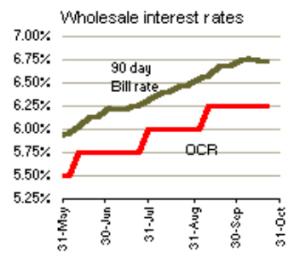
The money markets also expect him to raise rates. They have factored in at least 0.25% to the commercial bill rate, and have had this premium there since about a week after he raised it last time on 9 September.
His goal is to modify inflation by dousing the growing pressures in the booming housing sector. The latest CPI figures showed housing costs rising at the rate of 6.7% pa. while the average increase for all other eight groups in this Index was only 1.5% pa. The closely-watched "non-tradeables" component of the CPI remains high at 4.7% pa.
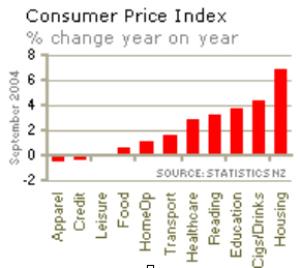
Dr Bollard's primary (only?) tool is the Official Cash Rate, the RBNZ's stand in the NZ money markets to lend or borrow at this rate. By setting the OCR, the Reserve Bank is able to substantially influence short-term interest rates, such as the 90-day bill rate, floating mortgages and the like. "In turn," says the RBNZ, "this influences the overall level of economic activity in the country and therefore inflation."
"The OCR was introduced as a device to implement monetary policy in March 1999. Compared to earlier systems used by the Reserve Bank, it is simpler and more easily understood." But the problem is it is not working.
Banks no longer lend significantly for housing on floating mortgages. Such mortgages account for less than 30% of all such loans on the bank's books, and as any banker will tell you, the number of new variable housing loans being written today is less than 10%.
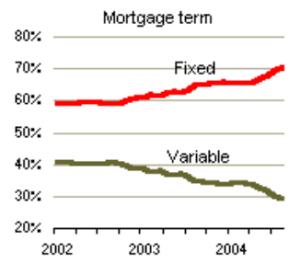
Most housing loans are being done on a fixed-rate basis – probably 90% or so in the current quarter. This insulates the consumer from Dr. Bollard's rate rises.
Further, the primary influence on longer term fixed-rate mortgage pricing is not the OCR, but international bond prices. Fixed rate mortgages are not funded by the Banks from the commercial bill market. The commercial bill market funds business borrowing, not residential housing.
The bond markets are rising, both here and overseas. That means bond interest rates are falling. For example, the benchmark NZ Government 10 year bond yield has fallen from 6.34% on 10 June when the OCR was raised to 5.75%, to 6.02% today when the OCR is expected to go to 6.50%. While the RBNZ is raising rates, bond yields are falling.
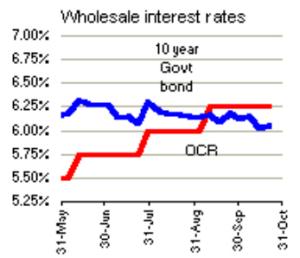
Little wonder then that mortgage consumers have switched to longer term fixed-rate arrangements.
The Banks themselves encourage that. The current mortgage 'war' for market share is being fought out in the two-year and three-year fixed-rate arena. And, as the BNZ's Tony Alexander and other bank economists have noted, this undermines what the RBNZ is trying to achieve.
By focussing on longer term fixed rates, this market is far less susceptible to public policy influence. At least $65 billion of the $92 billion in mortgage share the Banks hold has a varying number of months and years before the interest rate (and therefore the mortgage payment amount) is reset, and when it is, the prospects are strong that choosing a longer fixed period will save the borrower money.
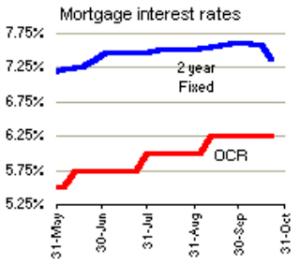
All this will make Dr Bollard's action even more remote from influencing housing costs.
Talking up the 'risks' and talking down the housing market is another weapon in the RBNZ's armoury. But that is not working either. There is talk of declining sales, but the REINZ numbers just show that volumes are only back to their 2001-2003 average, and that prices are not retreating. Talk of a cooling market is a little premature, as the latest figures are from the quiet period in the year, and we are about to enter the real selling season, Labour Weekend to Easter.
December 9 is when the RBNZ makes its
subsequent OCR announcement, and most economists are still
picking a rise from 6.50% to 6.75%. That will push floating
rate mortgages over 9%. You can bet on it that consumers
will have figured out that staying away from floating and
short-term fixed rates is the way to go, rolling over their
expiring fixed-term mortgages into longer-term fixed rates,
at levels way below the OCR-influenced options. Banks will
be at the forefront of laying out these options for their
customers.
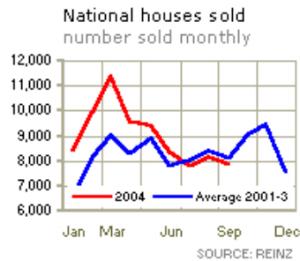
Where does Dr.
Bollard go from there? Does he continue to target the
'innocent' - the business community through his ratcheting
up of the 90 day Commercial Bill rates - to try and get at
the 'guilty' - the housing market, fuelled by consumer
demand? Or can he find a more direct way to achieve what he
needs to do?
The OCR has become out-of-date and ineffective for its stated public policy purpose. It may have crossed over to become part of the problem, not part of the solution.
end.


 Eugene Doyle: The Fall Of Saigon 1975 - Fifty Years Of Repeating What Was Forgotten
Eugene Doyle: The Fall Of Saigon 1975 - Fifty Years Of Repeating What Was Forgotten Peter Dunne: Dunne's Weekly - Trump's Tariffs Still Pose Risks For New Zealand
Peter Dunne: Dunne's Weekly - Trump's Tariffs Still Pose Risks For New Zealand Keith Rankin: Barbecued Hamburgers And Churchill's Bestie
Keith Rankin: Barbecued Hamburgers And Churchill's Bestie Gordon Campbell: On Why The US Stands To Lose The Tariff Wars
Gordon Campbell: On Why The US Stands To Lose The Tariff Wars Eugene Doyle: Before It’s Too Late - Reimagine New Zealand’s Military Future
Eugene Doyle: Before It’s Too Late - Reimagine New Zealand’s Military Future  Binoy Kampmark: Gender Stunts In Space - Blue Origin’s Female Celebrity Envoys
Binoy Kampmark: Gender Stunts In Space - Blue Origin’s Female Celebrity Envoys